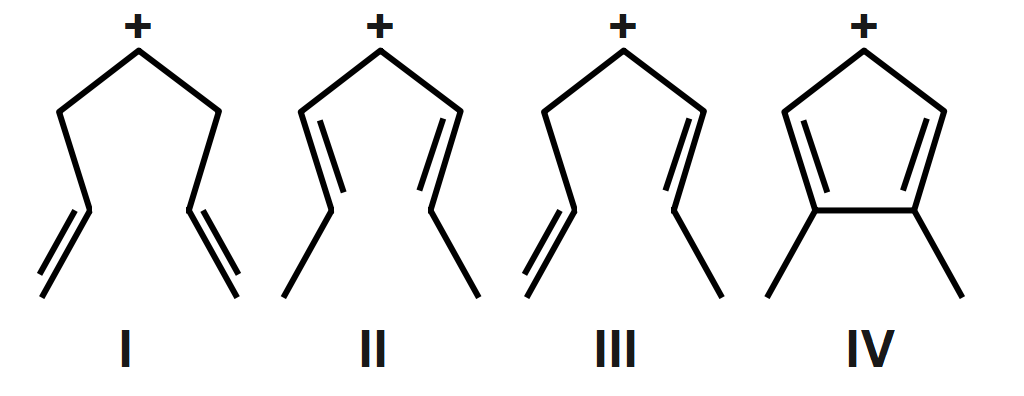
The Stability order of carbocation is:

A. $II>IV>III>I$
B. $IV>II>III>I$
C. $II>III>I>IV$
D. $I>III>II>IV$

Answer
521.4k+ views
Hint: Decide the stability of given carbocation by the number of resonating structures they can form. More resonating structures represent more stable carbocation. A carbocation carries a positive charge on the atom of a carbon. The name itself indicates that ‘carbo’ refers to the carbon atom while ‘cation’ refers to a positive ion.
Complete step by step answer:
Resonance stabilizes the structure and lowers the energy of the carbocation, as the question is asking about the stability of given carbocation, we will check first which structure shows more resonating structure. More number of resonating structures means more stability. Hyperconjugation also stabilizes the carbocation but its effect on stability is less considerable then that of resonance.
Different types of carbocations include primary, secondary and tertiary carbocations. In a primary carbocation, the carbon carrying the positive charge is attached to only one alkyl group. The structure II in the question contains a primary carbocation. In a secondary carbocation, the carbon carrying the positive charge is connected to two alkyl groups.
The structure I in the question contains a secondary carbocation. In a tertiary carbocation, the carbon carrying the positive charge is linked with three alkyl groups. The structure III in the question contains a tertiary carbocation. The structure IV in the question refers to resonance stabilized and thus, is the most stable. Among primary, secondary and the tertiary carbocations, tertiary carbocation is the most stable whereas primary carbocation is considered to be the least stable owing to the decreasing –I (inductive) effect of the alkyl group.
Here we have, \[II=\] resonance stabilizes with two pi bonds, \[III=\]resonance with one pi bond, \[I=\]hyperconjugation four alpha hydrogen, \[IV=\]anti-aromatic.
So, the correct answer is Option C.
Note: Always remember that alkyl groups are considered to be weakly electron donating groups owing to the presence of hyperconjugation as well as inductive effect. And the existence of resonance effect can add further stability to the carbocations. Resonance provides more stability than that of hyperconjugation.
Complete step by step answer:
Resonance stabilizes the structure and lowers the energy of the carbocation, as the question is asking about the stability of given carbocation, we will check first which structure shows more resonating structure. More number of resonating structures means more stability. Hyperconjugation also stabilizes the carbocation but its effect on stability is less considerable then that of resonance.
Different types of carbocations include primary, secondary and tertiary carbocations. In a primary carbocation, the carbon carrying the positive charge is attached to only one alkyl group. The structure II in the question contains a primary carbocation. In a secondary carbocation, the carbon carrying the positive charge is connected to two alkyl groups.
The structure I in the question contains a secondary carbocation. In a tertiary carbocation, the carbon carrying the positive charge is linked with three alkyl groups. The structure III in the question contains a tertiary carbocation. The structure IV in the question refers to resonance stabilized and thus, is the most stable. Among primary, secondary and the tertiary carbocations, tertiary carbocation is the most stable whereas primary carbocation is considered to be the least stable owing to the decreasing –I (inductive) effect of the alkyl group.
Here we have, \[II=\] resonance stabilizes with two pi bonds, \[III=\]resonance with one pi bond, \[I=\]hyperconjugation four alpha hydrogen, \[IV=\]anti-aromatic.
So, the correct answer is Option C.
Note: Always remember that alkyl groups are considered to be weakly electron donating groups owing to the presence of hyperconjugation as well as inductive effect. And the existence of resonance effect can add further stability to the carbocations. Resonance provides more stability than that of hyperconjugation.
Recently Updated Pages
Master Class 11 Economics: Engaging Questions & Answers for Success

Master Class 11 English: Engaging Questions & Answers for Success

Master Class 11 Social Science: Engaging Questions & Answers for Success

Master Class 11 Biology: Engaging Questions & Answers for Success

Class 11 Question and Answer - Your Ultimate Solutions Guide

Master Class 11 Business Studies: Engaging Questions & Answers for Success

Trending doubts
10 examples of friction in our daily life

One Metric ton is equal to kg A 10000 B 1000 C 100 class 11 physics CBSE

Difference Between Prokaryotic Cells and Eukaryotic Cells

1 Quintal is equal to a 110 kg b 10 kg c 100kg d 1000 class 11 physics CBSE

Explain zero factorial class 11 maths CBSE

What is a periderm How does periderm formation take class 11 biology CBSE




